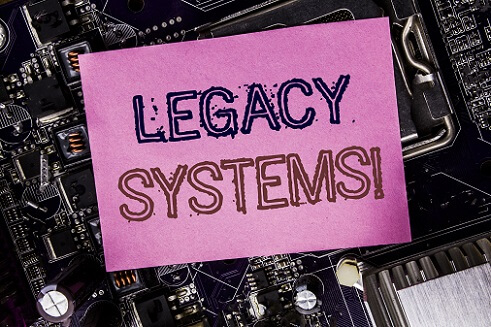How to Optimize Legacy Systems for Forward-Looking Change

Despite the chagrin regularly expressed about inflexible legacy systems, these systems continue to deliver significant value to organizations. How can you optimize and reshape your legacy systems to move forward as IT architecture changes?
First, let’s look at how IT architecture is evolving.
- IT is moving to the cloud, but not with the result of eliminating all in-house data centers.
- Compute and storage are being redistributed to the edges of enterprises.
- More mobile and Internet of Things (IoT) technologies are coming into play.
- Organizations want to leverage data from many sources to enrich their analytics.
- Security is paramount.
- Application time to market is critical.
- Business value also remains critical.
Arguments against legacy systems are that they:
- Are in-house oriented and not amenable to cloud deployment.
- Can’t handle distributed computing deployments.
- Are not as easily adaptable to mobile computing and IoT.
- Have lengthy application development cycles.
- Cost businesses a lot of money.
A legacy system is often described as an older methodology or technology resource typically tied to computer systems from prior generations that may even be obsolete. A system that is at least 10 years old may be labeled as “legacy.”
The initial impulse when imaging legacy systems is to think about mainframe computers or outdated ERP (enterprise resource planning) and accounting systems — but under certain definitions legacy can also include technologies such as Microsoft Windows and Office Suite, Oracle, SAP, VMware and Salesforce. Such IT solutions, which have seen frequent updates over the years, may be viewed as reliable and even indispensable. They might be called incumbent or legacy technologies, but their usefulness persists.
Several years ago, a SaaS cloud provider told me it moved to a bank of Linux-based, distributed Intel servers to process its financial transactions. The company never considered a mainframe solution because its staff had never worked with mainframes — they only read about them in books at college.
It turned out the company was unable to achieve its desired level of security, transaction performance or technical support from its initial computer provider. Despite its early trepidation, the company decided to benchmark a mainframe that hosted a series of virtual Linux servers on it. The company not only achieved the performance it wanted, but it got the security and technical support it sought, which prompted a switch.
This is not to say that legacy systems work for everyone — but they aren’t out of the running completely.
Organizations that have seen the greatest benefits from legacy systems are those that have learned to optimize their legacy investments. Here are six proven best practices:
1. Utilize the end to end resources of legacy system vendors
Oracle, SAP, Microsoft, IBM, Salesforce, and other legacy vendors have hundreds of thousands of clients, coupled with an extensive network of solution partners and consulting partners. They also offer internal consulting, special project, implementation, training, and technical support teams. These vendors offer flexible plans and single-use options that let you to prescribe and subscribe to the level of support that you need. This lets organizations manage their budgets as they rely on their vendors’ expertise when and where they require it.
2. Look to the cloud
Almost every legacy vendor now has cloud-based versions of systems that were formerly offered in-house only. This created enormous flexibility for most companies that now operate in a hybrid environment of both in-house and on-cloud computing.
For example, a large company running an in-house ERP system with significant customized code developed over the past 30 years doesn’t have to perform a total makeover if it acquires a smaller company not running the same ERP. As a first step, the parent company could opt to place the company it acquired on a more generic cloud-based version of its ERP system. That would let new employees learn the system. If the parent company chooses, it can bring the acquired company into its in-house enterprise ERP over time. This might reduce disruption to the business.
In other cases, a company may decide to keep an in-house ERP system but run a backup version of the system for failover purposes in the cloud. The company might also choose to migrate its ERP entirely to a cloud version.
The bottom line is that with today’s legacy systems, there may be options that let companies choose to host their systems anywhere they want to.
3. Think API
A common complaint about legacy systems is that they are difficult to integrate with, but many legacy systems have common application programming interfaces (APIs) that most applications and other systems can work with. Legacy vendors also have extensive networks of business partners and customers that compel other system providers to make it a priority to tailor APIs to work with such legacy enterprise systems. Successful legacy system customers know this and regularly use APIs to cross-connect platforms and applications. The one “catch” in this scenario is if a company has customized its legacy system to the point where it is difficult find a usable API. In that case, some hand coding might need to be done — but it’s also possible that a solution might be found Legacy system vendors are investing in mobile and IoT technologies and technology connecters. Some of this investment has been in internal RD, but just as often these cash rich vendors acquire newer and startup companies that have state-of-the-art technology that can enrich legacy systems with new functionality. Mobile and IoT solutions brought into the legacy fold feature best-of-class security, which is a hallmark of most legacy vendors. Successful legacy optimizers keep their ears to the ground, frequently checking with legacy system RD teams for new technologies and enhancements on the horizon.
Related Content:
How to Integrate Edge Computing With Your Core Systems
Why and How to Transition Your Company to the Cloud
COBOL, COVID-19, and Coping with Legacy Tech Debt
